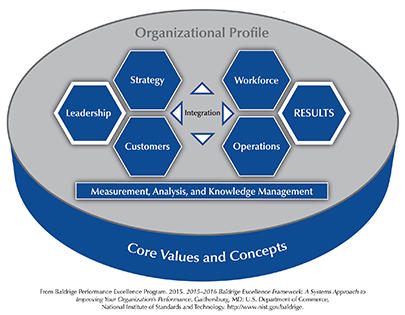Leadership Behaviors That Count (and Can Benefit All Organizations)

Dr. Harry Hertz, Director Emeritus
Baldrige Performance Excellence Program
August/September 2015
Introduction
As the following diagram of the Baldrige framework indicates, the basis of the Baldrige Criteria for Performance Excellence is a set of core values and concepts that are embedded in high- performing organizations.

These core values and concepts (listed below) are the foundation for integrating key operational requirements within a results-oriented framework that creates a basis for action.
Under the auspices of the Baldrige foundation, a set of leadership behaviors has been developed to reinforce these core values in high-performing organizations. They are behaviors that typify role-model leaders and can form the basis for leadership development and senior leadership team design. Senior leaders should build their own strength in these behaviors and also make sure that their leadership team embodies strengths that they do not personally possess with sufficient strength.
The Leadership Behaviors
The leadership behaviors are aligned with the 11 Baldrige core values and concepts, respectively. While all of the behaviors are important, it is critical that senior leaders possess and personally exhibit the executive behaviors associated with visionary leadership, systems perspective, ethics and transparency, and delivering value and results. They are central to the role of an effective leader. These behaviors are embodied in the "bookends" (first two and last two) of the core values and concepts.
Visionary Leadership
- Leads the organization in setting and owning organizational vision and values
- Guides the creation of strategies, systems, and methods to ensure ongoing organizational success
- Creates and ensures a supportive and collaborative environment
- Inspires the organization and others to achieve high performance
- Engages in personal learning seeking input from others
Systems Perspective
- Sets a systems perspective across the organization so that the organization and all of its parts are viewed as a whole
- Causes holistic thinking and cross-functional synthesis, alignment, and integration
- Requires a focus on strategic direction and customers to improve overall performance
Customer-Focused Excellence
- Builds a customer-focused culture and integrates customer engagement as a strategic concept
- Creates a focus on anticipating changing and emerging customer and market requirements
- Ensures differentiation from competitors through the development of organizational knowledge, skills, and core competencies
Valuing People
- Builds and fosters an organizational culture that focuses on engagement, development, and well-being of workforce members
- Creates an organizational environment that is safe, trusting, and cooperative
- Builds partnerships with internal and external people and organizations
- Capitalizes on the diversity of the workforce and partners
Organizational Learning and Agility
- Develops a capacity for rapid change and for flexibility in operations
- Leads and inspires the organization to make transformational changes despite ever-shorter cycle times
- Creates an empowered workforce that effectively uses evolving organizational knowledge
- Embeds learning in the way the organization operates
Focus on Success
- Creates a focus on short- and longer-term factors that affect the organization and its future marketplace success
- Leads the pursuit of improvement and innovation
- Ensures that organizational planning anticipates future marketplace and technological influences
Managing for Innovation
- Builds an environment that empowers the workforce to take intelligent risks
- Enables innovation to flourish and create value for stakeholders
Management by Fact
- Compels the organization to measure performance both inside the organization and in its competitive environment
- Uses data and analysis in decision making
- Challenges the organization to extract larger meaning from data and information
Societal Responsibility
- Acts as a role model for public responsibility and actions leading to societal well-being and benefit
- Motivates the organization to excel beyond minimal compliance with laws and regulations
- Drives environmental, social, and economic betterment of the community as a personal and organizational goal
Ethics and Transparency
- Requires highly ethical behavior in all organizational activities and interactions
- Requires organizational integrity
- Leads with transparency through open communication of clear and accurate information
Delivering Value and Results
- Leads the organization to achieve excellent performance results
- Defines and drives the organization to exceed stakeholder requirements and achieve value for all stakeholders
Some Research
For the past two years, the Baldrige Executive Fellows have been ranking these leadership behaviors, indicating those in which they possess strength and those in which they would most like or need to develop further ability. Interestingly, within the group of approximately 30 fellows there was significant agreement in the rankings. Their top two areas of strength were the behaviors associated with visionary leadership and valuing people. For the 2015 fellows, ethics and transparency was also among the top strengths. This core value was broken out from visionary leadership in 2015; thus the 2014 fellows did not see this core value on their list. In the area of needing to build greater competency, fellows in both cohort years included customer-focused excellence, systems perspective, managing for innovation, and organizational learning and agility.
Of the four core values designated as essential behaviors for senior leaders, two were designated as strengths by the group (visionary leadership and ethics and transparency), one as an area for learning emphasis (systems perspective), and one was considered an adequate skill (delivering value and results). In five studies of 2015 CEO challenges and opportunities, the one opportunity mentioned in all five studies was the need to build stronger customer relationships. This need ties directly to the Baldrige fellows' perceived need to build greater competency in customer-focused excellence. They apparently share a common need with the thousands of senior executives in the five studies. This need for senior executives is based on several factors: customers setting higher expectations, customers wanting customization in offerings, and the greater availability of data and analytics that can be used in understanding individual and aggregated customers.
The five studies also emphasized senior executives' opportunities in the areas of ethics and creativity, closely tied to core values the Baldrige fellows identified as a strength (ethics and transparency) and as a need (managing for innovation and organizational learning and agility).
In 2010, Joe Folkman published a study of the top nine leadership behaviors that drive employee commitment. The study gathered data from nearly 10,000 direct reports. Folkman focused on leadership behaviors that drove employee commitment because leadership effectiveness increased productivity and profitability even in difficult times. Seven of the nine behaviors identified were embodied in the leadership behaviors associated with visionary leadership, valuing people, and ethics and transparency. The overlap in this study with the data already presented gives a broader sense of the importance of these specific behaviors.
Innovation is inherent in a learning organization. As indicated above, recent Baldrige fellows have recognized the importance of learning and innovation to the future success of their organizations and have seen these areas as current challenges for them. There have been numerous studies on the positive relationship between organizational learning and innovation, as well as the impact on organizational performance (see, for example, this study in the Journal of Business Research). While the behaviors associated with all 11 Baldrige core values are important, these studies give particular focus to the need for leadership strengths in the areas of setting vision, ethics and transparency, a systems perspective on their organization, delivering organizational value and results, organizational innovation and learning, valuing people, and building customer relationships.
Your Leadership Opportunities
We all have the opportunity to improve our leadership skills. Here are some suggestions based on the information above:
- Look at your leadership behavior strengths and opportunities relative to the 11 Baldrige core values and concepts.
- Pay particular attention to the three core values that Baldrige fellows have indicated as personal strengths and that Folkman says are important: visionary leadership, valuing people, and ethics and transparency.
- Evaluate your opportunity to enhance customer-focused excellence, an opportunity for Baldrige fellows and a key opportunity for senior executives broadly.
- Look at the behaviors associated with the two remaining Baldrige core values designated as essential behaviors: systems perspective and delivering value and results.
- Evaluate your behaviors that encourage organizational learning and agility and managing for innovation. They almost certainly affect the future success of your organization.
Set your personal learning agenda based on enhancing your strengths and addressing key opportunities. You and your organization will benefit!
Resources
Baldrige Excellence Framework
Baldrige Excellence Builder
Blogrige
News
If You Want to Build Trust, Collect Trash (February/March 2015)
People, Process, and Plentiful Passion (April/May 2015)
It Is 2015. Is Your CEO Thinking about Current Issues? (June/July 2015)
Archived Columns
You need to have Acrobat Reader installed on your computer to view the PDF file. If you do not have Acrobat Reader installed on your computer, download the program at http://get.adobe.com/reader. People with visual disabilities can download tools and information at http://www.adobe.com/accessibility to help make Adobe PDF files accessible.
Contacts
-
Baldrige Customer Service(301) 975-2036NIST/BPEP
100 Bureau Drive, M/S 1020
Gaithersburg, MD 20899-1020

